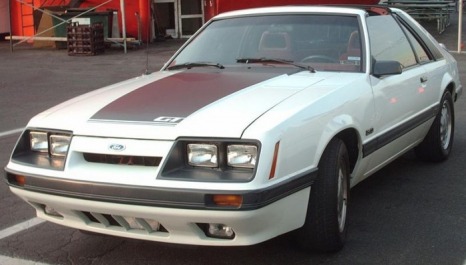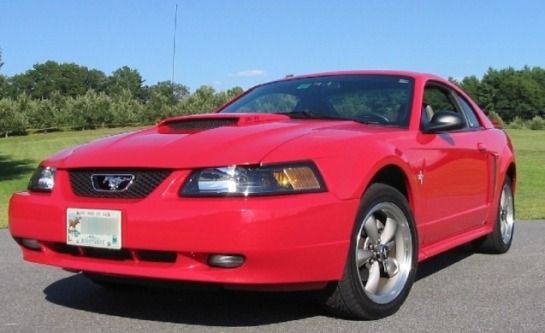Yesterday Mustangs
Third Generation (1979–1993)
The 1979 Mustang was based on the larger Fox platform (initially developed for the 1978 Ford Fairmont and Mercury Zephyr). The interior was restyled to accommodate four people in comfort despite a smaller rear seat. The trunk was larger, as was the engine bay, for easier service access.
Body styles included a coupé, (notchback) and hatchback; a convertible was offered in 1983. Available trim levels included L, GL, GLX, LX, GT, Turbo GT, SVO (1984-86), Cobra, and Cobra R (1993).
In response to slumping sales and escalating fuel prices during the early 1980s, a new Mustang was in development. It was to be a variant of the Mazda MX-6 assembled at AutoAlliance International in Flat Rock, Michigan. Enthusiasts wrote to Ford objecting to the proposed change to a front-wheel drive, Japanese-designed Mustang without a V8 option. The result was a major facelift of the existing Mustang in 1987, while the MX-6 variant became the 1989 Ford Probe.
Body styles included a coupé, (notchback) and hatchback; a convertible was offered in 1983. Available trim levels included L, GL, GLX, LX, GT, Turbo GT, SVO (1984-86), Cobra, and Cobra R (1993).
In response to slumping sales and escalating fuel prices during the early 1980s, a new Mustang was in development. It was to be a variant of the Mazda MX-6 assembled at AutoAlliance International in Flat Rock, Michigan. Enthusiasts wrote to Ford objecting to the proposed change to a front-wheel drive, Japanese-designed Mustang without a V8 option. The result was a major facelift of the existing Mustang in 1987, while the MX-6 variant became the 1989 Ford Probe.
Fourth Generation (1994–2004)
In 1994 the Mustang underwent its first major redesign in fifteen years. Code named "SN-95" by Ford, it was based on an updated version of the rear-wheel drive Fox platform called "Fox-4." The new styling by Patrick Schiavone incorporated several styling cues from earlier Mustangs. For the first time since 1973, a hatchback coupe model was unavailable.
The base model came with a 3.8 OHV V6 (232 cid) engine rated at 145 bhp (108 kW) in 1994 and 1995, or 150 bhp (110 kW) (1996-1998) and was mated to a standard 5-speed manual transmission or optional 4-speed automatic. Though initially used in the 1994 and 1995 Mustang GT, Ford retired the 302 cid pushrod small-block V8 after nearly 40 years of use, replacing it with the newer Modular 4.6 L (281 cid) SOHC V8 in the 1996 Mustang GT. The 4.6 L V8 was initially rated at 215 bhp (160 kW), 1996-1997, but was later increased to 225 bhp (168 kW) in 1998.
For 1999, the Mustang received Ford's New Edge styling theme with sharper contours, larger wheel arches, and creases in its bodywork, but its basic proportions, interior design and chassis remained the same as the previous model. The Mustang's powertrains were carried over for 1999, but benefitted from new improvements. The standard 3.8 L V6 had a new split-port induction system, and was rated at 192 bhp (143 kW) 1999-2004, while the Mustang GT's 4.6 L V8 saw an increase in output to 260 bhp (190 kW) (1999-2004), due to a new head design and other enhancements. There were also three alternate models offered in this generation: the 2001 Bullitt, the 2003 and 2004 Mach 1, as well as the supercharged Cobra.
The base model came with a 3.8 OHV V6 (232 cid) engine rated at 145 bhp (108 kW) in 1994 and 1995, or 150 bhp (110 kW) (1996-1998) and was mated to a standard 5-speed manual transmission or optional 4-speed automatic. Though initially used in the 1994 and 1995 Mustang GT, Ford retired the 302 cid pushrod small-block V8 after nearly 40 years of use, replacing it with the newer Modular 4.6 L (281 cid) SOHC V8 in the 1996 Mustang GT. The 4.6 L V8 was initially rated at 215 bhp (160 kW), 1996-1997, but was later increased to 225 bhp (168 kW) in 1998.
For 1999, the Mustang received Ford's New Edge styling theme with sharper contours, larger wheel arches, and creases in its bodywork, but its basic proportions, interior design and chassis remained the same as the previous model. The Mustang's powertrains were carried over for 1999, but benefitted from new improvements. The standard 3.8 L V6 had a new split-port induction system, and was rated at 192 bhp (143 kW) 1999-2004, while the Mustang GT's 4.6 L V8 saw an increase in output to 260 bhp (190 kW) (1999-2004), due to a new head design and other enhancements. There were also three alternate models offered in this generation: the 2001 Bullitt, the 2003 and 2004 Mach 1, as well as the supercharged Cobra.


